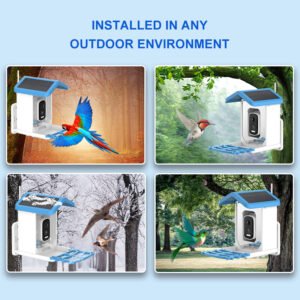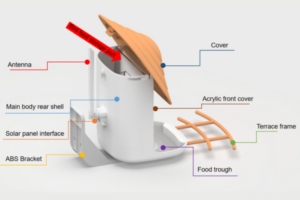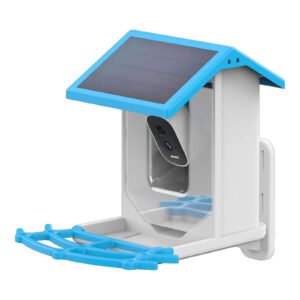Struggling to attract birds to your window bird feeder? You’re not alone—many bird lovers face the challenge of drawing feathered friends to their feeders. If left unchecked, the frustration can grow, and you might give up on the idea altogether. But don’t worry—this article will help you solve this issue and bring the birds to your window feeder in no time.
Attracting birds to your window bird feeder requires the right approach. A well-positioned feeder with suitable food can make all the difference. This guide will help you understand what draws birds in, how to improve your chances, and why some feeders work better than others.
Ready to learn how to make your window bird feeder more inviting? Let’s dive into the details.
Why Won’t Birds Come to My Window Bird Feeder?
If birds aren’t visiting your window bird feeder, there could be several reasons why. First, it’s important to consider whether the feeder is in a suitable location. If the area is too noisy or lacks natural cover, birds may avoid it. Additionally, if the feeder is not cleaned regularly, it could be attracting unwanted pests, making it unappealing to birds. Birds also have specific food preferences, so using the wrong seeds or not providing enough variety might keep them away. Lastly, it’s possible that birds simply haven’t discovered the feeder yet. It can take time for birds to notice a new feeder.
How Do I Get Birds to Find My Window Feeder?
One of the best ways to help birds discover your window feeder is by offering food that they love. High-energy seeds like sunflower seeds are known to attract many types of birds. Another helpful tactic is to place the feeder near plants or trees, providing cover for the birds. Birds feel safer when they have nearby places to hide if they need to. Also, consider using a window bird feeder without suction cups for a sturdier, more reliable option that can withstand weather changes. Regularly refill the feeder, and soon enough, birds will start noticing it.
How Do You Draw Birds to a Window Feeder?
Drawing birds to your window feeder is all about making it an inviting spot. Make sure the food is fresh and appropriate for the species you’re hoping to attract. Offering a variety of seeds, such as black oil sunflower seeds, will cater to different bird types. Placing the feeder at eye level can also make it more visible to birds and easier for you to observe. Additionally, placing a birdbath nearby can help attract birds as they are drawn to water sources as well as food. Finally, be patient—birds need time to get accustomed to their new feeder.
How Long Does It Take for Birds to Come to the Window Feeder?
The time it takes for birds to come to your window feeder can vary depending on several factors. Typically, it could take anywhere from a few days to a few weeks for birds to start visiting consistently. Some birds may be more cautious than others, so don’t be discouraged if they don’t show up immediately. If you’ve placed the feeder in a good location and provided the right food, they will eventually find it. If you’re wondering how to attract birds to a new feeder in winter, consider that colder months can delay their response, as food sources become more limited and they are more cautious.
Where’s the Best Place to Put a Window Bird Feeder?
The location of your window bird feeder is crucial for attracting birds. Ideally, place it in a quiet, undisturbed area with plenty of natural cover, like trees or shrubs. Birds feel more comfortable when they have nearby shelter to retreat to. Ensure the feeder is placed at eye level so you can easily watch the birds. It’s also important to place the feeder where it will get enough sunlight, but not too much that the food becomes spoiled. Window bird feeders without suction cups are also a better choice, as they are more durable and easier to maintain.
Why Aren’t Birds Coming to My Feeder?
There are many possible reasons why birds aren’t coming to your feeder. It could be due to food choices—birds are picky eaters, and they may prefer a different type of seed. Another reason could be the placement of the feeder. If it’s located in a high-traffic area or lacks shelter, birds may not feel safe visiting it. Make sure the feeder is clean and free of mold or pests, as this could deter birds from coming. It’s also important to remember that some birds are more cautious than others and may need time to get comfortable with a new feeder.
Do Window Bird Feeders Work?
Yes, window bird feeders can be highly effective at attracting birds if placed in the right location and stocked with the right food. They offer an up-close and personal bird-watching experience, making them a popular choice for many bird enthusiasts. However, not all window feeders are created equal. Some may be harder to clean or maintain, or they might not be sturdy enough to withstand certain weather conditions. Choosing the best window-mounted bird feeder is key to ensuring long-term success.
Do Birds Tell Each Other Where Food Is?
Yes, birds are known to communicate about food sources. While they don’t leave verbal messages, they do use visual cues and behaviors to alert other birds to food sources. For instance, one bird might discover a feeder and then call to others or show them where to find the food. Birds also have excellent memories and can often remember where they’ve found food in the past, so over time, they’ll return to the same feeders.
What Attracts Birds the Most?
The most attractive food for birds tends to be high-energy seeds like sunflower seeds, which are favored by many species. Additionally, suet, nectar, and peanuts are also popular among different bird types. But it’s not just about the food. Birds are also attracted to feeders that are safe and secure. They prefer locations that offer both food and nearby shelter, such as trees or shrubs, which give them a place to retreat to if needed.
Do Birds Recognize Humans Who Feed Them?
Yes, birds can recognize humans who regularly feed them. Over time, they will associate a specific human with food. This recognition is typically based on visual and auditory cues. If you are consistently providing food at the same location, the birds will begin to trust you, and they may feel more comfortable coming to your feeder. They may even begin to recognize you as a safe source of nourishment.
Why Do Birds Throw Seed Out of Feeders?
Birds often throw seeds out of feeders for a few reasons. Some species are selective eaters and may only prefer certain seeds, discarding the ones they don’t like. Others might simply be hoarding food for later, scattering the seeds as a way of taking some away from the feeder. Additionally, the design of some feeders may allow seeds to fall out, especially if they are not securely held in place. It’s important to choose a well-designed window bird feeder that minimizes seed waste.
How Long Does It Take for a Bird to Come to After Hitting a Window?
If a bird hits a window, it can be disorienting for them, but most recover quickly. Depending on the severity of the collision, it could take anywhere from a few minutes to several hours for the bird to recover fully. Providing a safe space for the bird to rest can help speed up recovery. If you notice a bird lying still after hitting a window, it’s best to wait until it is fully alert before leaving the area.
Do Bird Feeders on Windows Work?
Bird feeders on windows can work very effectively, especially when they are placed in the right location. The key to success is choosing the right type of feeder and filling it with the right kind of food. Many birds are attracted to window bird feeders because they offer a close-up view and a steady food source. However, you should make sure that the feeder is secure and can withstand outdoor conditions to prevent it from falling or getting damaged.
How Do You Get Birds to Come to Your Window?
To attract birds to your window, it’s important to make the feeder as inviting as possible. Use high-quality, bird-friendly food like sunflower seeds and hang the feeder where birds can see it easily. Placing the feeder near trees or shrubs will also make birds feel safer. Over time, birds will start to notice the feeder, especially if it’s regularly stocked with fresh food.
How Long Does It Take for a Bird Feeder to Work?
Typically, it takes anywhere from a few days to a few weeks for a bird feeder to start working. Birds need time to discover it, especially if it’s in a new location. The key is consistency—regularly fill the feeder with fresh food, and ensure it’s in an area that attracts birds. With time, you’ll see more birds visiting your window bird feeder.
Summary
Attracting birds to your window feeder is all about the right food, placement, and patience. Follow these tips for success.






